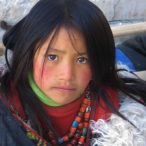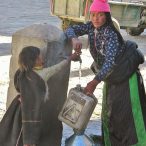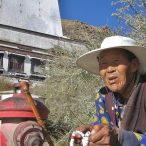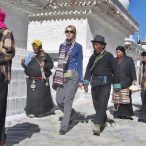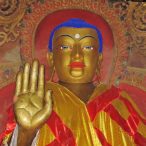Tibet
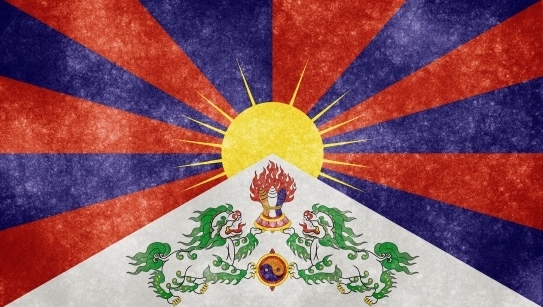
Official name: Tibet Autonomous Region
Population: 3 180 000
Area: The total area of Tibet (3 traditional provinces) is 2 500 000 km², but the area of the Tibet Autonomous Region defined by China is only 1 228 000 km².

Gallery
Tibet – tourist attractions, Tibet travel rules, the present times, the recent history of Tibet.
Tourist attractions of Tibet
Tibet is a combination of a very old culture based on Buddhism and beautiful Himalayan views. Usually the first contact with this country is the holy city of Lhasa, where we have our first contact with the far away culture and architecture of Tibet. The most impressive are the few hundred year old temples, such as: Potala Palace, Barkhor square and Jokhang temple. I want to add that Potala Palace was always the traditional home to all Dalai Lamas, until Tibet was not taken over by the People`s Republic of China.

Tibet – Om Mani Padme Hum. (An ancient Buddhist mantra often repeated in Tibet, which means “Praise to the Jewel in the Lotus.” A lotus flower is an important symbol in many cultures, but particularly in Buddhism. The lotus flower is revered as a symbol of rebirth, purity, self-regeneration and spiritual enlightenment. After the Buddha was born, he walked seven steps, and lotus flowers grew under his feet.
To me it was a great culture shock to see how Tibetans pray, how they carry out their rituals, and how they dress. I also recommend the second largest town after Lhasa, called Shigatse. There is an impressive Buddhist temple from the XV century called Tashi Lhunpo. Another tragic but culturally fascinating places are the towns of Sakya and Shegar, which illustrate the great harm done to the Tibetans by China. These are great eye openers to the cause of Tibet. You can also try yak`s butter, buy souvenirs, see women washing clothes in the icy river and enjoy the views of the Himalayas. Unfortunately, great views and Buddhist temples are not the only thing. There is also the extreme poverty, poor and stripped children and the general desperation of Tibetans, who live in inhumane conditions. Another great experience for me was the tiny settlement of Rongbuk, where I spent a night in bare walls without heating, whilst it was -25oC outside.
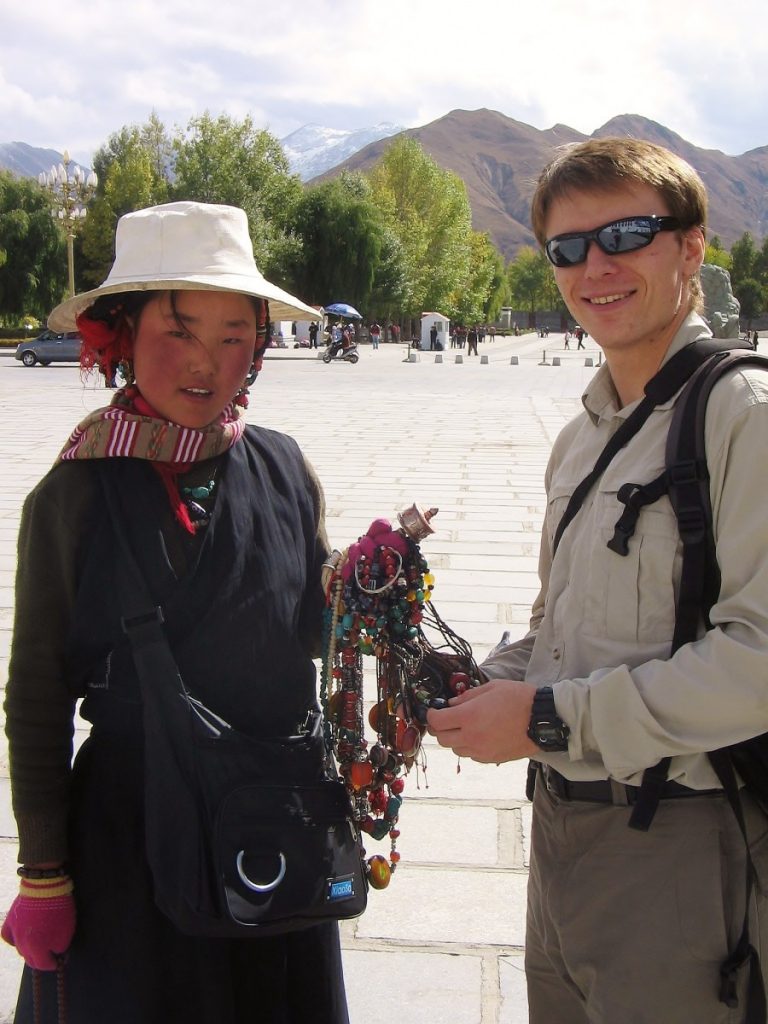
With a Tibetan girl selling beads.
Then I went towards Mount Everest, and I got to 5500m above the sea level. On the way I also saw a herd of mountain goats. There are many beautiful trails in Tibet but I went through the “friendship highway” all the way to Nepal. Along the way I admired the peaks of the Himalayas, snowy valleys, turquoise lakes and glaciers. Tibet also gives a chance to rest from civilization diseases and from air and water pollution. Throughout my Tibetan adventure I was breathing in crystal clear air and I ate natural food, and then I finally got to Zanghmu, the border with Nepal. It was warmer there because it was lower, and it was possible to eat something better and get a taste of curry. Zanghmu is also a good place to by out of date Snickers bars, which Tibet is famous for.
Tibet is a very hard country to travel because of the cold, high altitude and very basic conditions available, which are necessary for survival. However travelling around Tibet is a magical experience. I recommend Tibet to everyone because it gives an opportunity to see the magnificent natural beauty and it is a truly exciting adventure on the roof of the world. All tours can be arranged in Lhasa, and the “friendship highway” is just one of many beautiful experiences. I highly recommend all the freezing turquoise lakes, which are located in many parts of Tibet. Another very popular adventure is a train ride from Beijing to Lhasa, which runs through the whole of China and the beautiful landscapes of Tibetan Himalayas. I saw the lake of Yamdrok – Tso, where local people offer yak rides.

A female traveller from Poland in the Tashi Lhunpo monastery in Shigatse. Tibet.
Tibet is one of the most tragic but at the same time one of the most beautiful adventures in my entire travel career. I also want to add the Nepal is also a very good place for buying Tibetan souvenirs. In Kathmandu in Thamel district, among many other things you can buy for example fridge magnets and t-shirts with written “Free Tibet”.
Tibet travel rules
The rules of travelling to Tibet are complicated because the Chinese government does not want too many people to go there. On the other hand, ironically these communists are the biggest capitalists who will do anything for business. When I applied for Chinese visa and I had to select all the places that I wanted to see in China, I could not say that I wanted to visit Tibet because I wouldn’t get my visa. Expedition around Tibet has to be organized inside China. When applying for Chinese visa in Nepal, you also have to take a risk of not getting the visa because it is obvious that travellers will first go to Tibet. Around the whole of China we can travel freely, but to Tibet we need a special (paid!!!) license. When I bought a flight ticket to Tibet for 900 yuan, I had to pay 1300 yuan, because the rest of the money went for the permit. Without the permit even if you buy a ticket you will not be admitted on board. These rules may change even tomorrow because the system is very unstable. This way the Chinese government carries out its “mission of grace” in Tibet. It is also important that the license itself is valid only inside the capital of Lhasa and its outskirts. If you want to travel to the other and more distant parts of Tibet, you need a different (also paid!!!) permit, which can be organized only by travel agencies controlled by the Chinese government.
Tibet – the present times
Introduction:
The full name of this country is the Autonomous Region of Tibet. It is a great misfortune that Tibet is under Chinese occupation and its spiritual leader the Dalai Lama can not return to his country. I deliberately did not include Tibet in my journal about China, because to me it is a different country, what I have learned whilst being there.

The Potala Paalace. Lhasa, Tibet.
Great American and European trade with China makes it very unlikely for anyone to aproach China on the Tibet issue. In my experience today’s Tibet is a police state where Chinese police patrol the streets and temples. Fortunately, despite the strong influence from China, religion and culture of Tibet has survived and Tibetans practice their traditions as it is seen in the capital city – the holy city of Lhasa. Someone once said that “they can destroy the walls but as long as there is faith in people they can`t destroy the nation”, and there is faith in Tibet. I’ve read that less Tibetans now enter into a life of a Buddhist monk and wealthier people send their children to schools in Beijing and Shanghai. However tradition, clothing or even hair styles show that Tibetan spirit is still alive. In the capital of Lhasa it is forbidden to speak about the Dalai Lama or be in possession of his photographs. It is not allowed to talk about him and parts of religious rituals are controlled. There are a lot of spies who get money when they hear or see something pro-Tibetan and then report it to the Chinese police. It is very important to not to make a mistake. I witnessed all of that, and although I`m not Tibetan I understand these people because I know Polish history. Certain things over there are very emotional and at the sight of the Chinese police, both Tibetans and tourists, get a very painful rash.
The case is very simple. Tibet is a very special place for me and for Tibetans, and in a very vicious way also for the Chinese. The Chinese government is so smart that they came up with a plan of building a railway from Beijing to Lhasa. The train is equipped with oxygen cylinders because many people have altitude sickness. (This is mainly characterized by breathing problems, headaches and dehydration). The journey takes 48 hours and in certain places takes passengers above 4000m above the sea level. Dalai Lama has warned that the rail may result in even more loss of the cultural identity of Tibetans, what of course takes place already.
The Chinese government is so “generous” that it offered, that any Chinese who wants to settle in Tibet doesn’t have to pay for a ticket and will also get help in settling there. The Government’s aim is to settle Chinese people in Tibet to simply outnumber Tibetans in their own land. Besides, China’s totalitarian politics is identical to the policies of Stalin but this is happening in the XXI century and the world world turns a blind eye to it because it pays. The Chinese government does only put Chinese on high rank positions but also Tibetans, what has a much greater effect on the loss of the Tibetan people`s identity, and helps to maintain control over the country. Then the ego of those traitors builds to the height of Mount Everest. It makes them spies against their own people and gives them false sense of security. Tibetans are afraid to openly talk about this problem, although they sometimes open to tourists. When I was in the Potala Palace I asked a Tibetan guide why the Chinese police eats all the time. He said ironically that this is because they worked so hard in Tibet. Chinese police also steals money from Tibetan temples to pay for their pleasures. Sometimes people can no longer stand this terrible occupation. When I was there, a little earlier one monk ran into a street and began shouting “Free Tibet, Fuck China!”. Since then, no one ever saw him nor his family again.
On the other hand I’ve noticed exactly the same situation in the United Kindom, where the politics of White Apartheid puts the native British people on the last place, and promotion of mixed relationships and Third World invasion lead to the ultimate denationalization of the British nation. The Chinese government is still better because it helps their own people at the cost of the Tibetans, but the British government helps alien offenders at the cost of the White people. Sick and dirty, isn’t it?

The Potala Palace in the capital city of Tibet, Lhasa.
Economy:
Tibet’s economy relies heavily on agriculture, and is dependent on how China wants to develop it for their own needs. On the Tibetan Plateau very little land is suitable for cultivation, and that`s why Tibetans are mainly engaged in animal husbandry, such as: sheep, goats, cows, yaks, donkeys, camels and horses. In Tibet with the help of primitive tools and yaks people grow mainly: oats, barley, rye, cotton, potatoes and other vegetables and fruit. From what I’ve noticed a greater choice of food is only available in Lhasa, and in small villages poverty and hunger exist to such point that when I got out of my car in Shigatse and Shegar, children ripped food out of my hand. Even though fruit and vegetables are grown in Tibet I never saw any. Whilst traveling across Tibet, when I stayed in small villages children were begging me for biscuits, they were dirty and cold. Given the climate of Tibet fruit are grown only in the lower parts of the Himalayas closer to the border with Nepal, which are then exported to China.
The Chinese government says it doesn’t take taxes in Tibet and it covers Tibet`s expenses by 90%, although whilst travelling around the region I quickly realized that it was a mere lie, because Tibetan poverty is depressing. Based on the public opinion that the Chinese government “graciously helps” Tibet, I do not understand why poor Tibetans live in mud huts insulated with their animals` wastes, and Chinese live in brick houses. Official figures tell us that between 2000-2006 the economy of Tibet increased by 12% per year, but according to my own research it means that China’s economy grew by the further 12% at the expense of Tibet. Tibet itself is a poor police state of China, where there is hunger, lack of health care and education. The Chinese government organizes the uplifting spirits meetings during which they announce that they invest billions of dollars into Tibet to improve the living conditions of Tibetans, they want to increase their salaries and give free education.

A Tibetan granny.
In my point of view it translates into big words and small actions. China also invest in mining and construction factories in Tibet. The Chinese government operates in this sector with huge amounts of money “out of the goodness of their hearts”, employs Tibetans paying them with “a bowl of rice” and exports goods to China, whilst Tibetans still live in mud huts and have not much to eat. When I ordered a meal in a restaurant in a small village in Tibet, they didn’t have any food so they gave me a soup. It was tragic when I got only a bowl of hot water with chopped carrots. This is yet just one more example Chinese care and hospitality. China is so ironic that they published an article in a newspaper entitled “50th anniversary of democratic reforms in Tibet”, and Chinese people raised on lies of the Communist Party honestly believe they help Tibet. China is also very surprised by “the growing nationalism of Tibetans”, what means that in the case of uprising the economic growth of Tibet falls, what translates into even greater misery and a number of casualties. China also benefits from Tibetan tourism industry, which has improved after construction of railway from Beijing to Lhasa in 2006. Since than Tibet has been visited by about 3 million tourists a year, but mainly from China. However only about 150-200.000 foreigners visit Tibet every year as China limits us for political reasons. Tibetans have developed souvenir business, including carpet industry. Tibetan gifts are so beautiful that they sell them not only to tourists but also to other Tibetans. China sells those carpets and other souvenirs to Europe and North America.
As we can see Tibet is very important to China because this way the Chinese can legally steal from Tibet and get richer on their nightmare. According to UNDP China Human Development Report from 2007/2008, the average annual salary in Tibet is only about £200.
Education:
China is responsible for education in Tibet . Although Tibetan education exists, it is done in such a way to erode Tibetan culture. It is true that there are schools where many subjects are taught in Tibetan, but natural sciences are taught only in Chinese. A lot of Tibetans select only Tibetan education which is available, but after finishing such schools they can`t find a job. The Chinese on the other hand insist that learning Mandarin will improve the Tibetans` economic situation. Tibetan schools are controlled by the Chinese government and therefore they do not provide knowledge about local history and culture. There is also the University of Tibet, where Tibetans account for 60% of all students and have a choice of education in Tibetan, but then unfortunately it has a bad effect on getting a job.
According to available data, more than 90% of children are enrolled to primary schools and attendance is also very good, but on the other hand teaching has little effect when Tibetan children speaking only Tibetan are thought by Chinese teachers who speak only Chinese. Although the Chinese government has begun to subsidize the cost of tuition for the first 9 years, it does not cover food, clothing, medicine and housing. Many families in Tibet simply can not afford to send their children to school. In Tibet there is still a huge backwardness and ignorance and education to a large population consists only of folk beliefs and superstitions based on Buddhism. According to data that I have found only 13% of women and 35% men in Tibet are literate. Another source shows that about 45% of Tibetans are illiterate, what means that both sources more or less cover each other, however the truest data are censored by the Chinese government.
Health:
Tibet has a lot of diseases, but still taking into account the climate it has incomparably less than India. Tibet is a very large area with an approximate size of half of Europe, where people live far away from each other and transport is problematic and unreliable. There is also a great poverty in Tibet, and although medical situation has improved it is still at a very low level. This vast country (region) does not have enough hospitals and medical points outside the main towns, and there is not enough equipment. For example women’s health, pregnancy, childbirth and sexual health is still a taboo in Tibet. Still about 15% of children are malnourished, 34% are anemic due to too little iron, and 40% have intestinal worms. The blame for this situation is in the enormous poverty of Tibetans living in the countryside, which is the main reason why children do not have basic diet for their development. A research has been conducted on people living in rural Tibet, and found out that only 30% of them eat meat, and eggs and rice are eaten only once a month. It`s been also calculated that a lot of children from rural Tibet were smaller and lighter than the children from Lhasa.

A female traveller from Poland with an original face of Tibet.
Official data on the Tibetan health system drama are censored by the Chinese government, but it is believed that about 10% to 30% of all children die before their first birthday. Even in Lhasa which is the most modernized city and where there are a lot of hospitals, there is no adequate medical care or equipment, and about 96% of women give birth at home. Tibetan doctors spit on wet floor in a hospital with no electricity, and to help in the sufferings of women they offer herbs and prayers, but not a midwife. Mortality of women during childbirth in Tibet is one of the highest in the world. It is estimated that about 500 women die on every 100,000 births. (Sierra Leone for example is the “undisputed champion of the world” – 2,000 deaths per 100,000 childbirths). This time the whole blame can`t be put only on China, because the Chinese still invest something. This horror is caused but the great ignorance of Tibetans based on beliefs and superstitions of the people. It is said in Tibet that the blood coming from labour is dirty and that’s why women should not give birth at home or in a hospital but in a stable. There is also a perception that people can be jealous of pregnant women and might wait to hurt expecting mother. (It is not an opinion of every Tibetan, although I recommend my chapters about education and culture). There is also a belief in Tibet that death during childbirth is very natural and that pregnant woman are only pregnant but not sick, and therefore they do not need to go to a hospital.
Travellers should get vaccinated against: hepatitis A and B, typhoid, and eventually against rabies. A major problem in Tibet is in tuberculosis and dehydration, mainly because of the altitude. Most Tibetans live in areas above 3000 meters above the sea level, what gives Europeans a feeling of dizziness and lack of breath. The acclimatization period should pass quickly as long as we’re healthy. In the higher parts of Himalayas, over 4000 – 5000m above the sea level, a much longer acclimatization is needed, and also a vehicle to be able to quickly drive down if necessary. Tibet is not recommended to children, pregnant women and people with heart and lung diseases. Altitude sickness involves a lot of unpleasant experiences, that is why I would advise to take it seriously. Malaria occurs only in a small section along the Zangbo river (the very south-east of Tibet).
When it comes to HIV/AIDS Tibet is a low-risk country. I’ve been able to find data of 41 people infected by the virus. Unfortunately I suspect that this number will be rising as neighboring countries like India or China have big problem with HIV, and sexual way in this case is the most common form of infection, but also blood transfusion in hospitals!!! The problem is also in shyness, lack of support and lack of education of Tibetans on this topic.

Mount Everest, Tibet.
Culture/Religion:
Tibetan culture is based on Buddhism and folk beliefs, which is associated not only with religion, but also with costumes, architecture, art, hair styles, dancing and many other things. Tibetan culture was influenced by the cultures of India, Nepal and China. Until 1951 when Mao Zedong included Tibet to China, thanks to the vast distances and difficult access to Tibet and very harsh climate, local culture and customs were preserved. Unfortunately, since 1951 China has been doing whatever there is in their power to eradicate Tibetan traditions from the surface of the earth, just like the British government is doing what it can to denationalize its own nation. Tibetan Buddhism has its own unique form and apart from Tantra and Mahayana influences it also took over some of the Bon beliefs, which is the ancient religion of Himalayan shamans. Buddhism was introduced to Tibet in the VII century. Due to the very cold climate, vast area, and little land suitable for cultivation, also a grazing culture has been shaped, what in Tibet means expeditions to the beautiful landscapes of the Himalayas, where Tibetan herders eat, drink, and get cold, and the animals strip pastures of grasses. Although many species of animals are kept, yak is the symbol of Tibet. Maybe it is a tragic irony, but the art, a whole civilization of Tibet, as well as barley beer, technology of making yak butter, cheese, and drinking tea were taken from China. Also, Buddhist missionaries came primarily from China and Nepal. To a very little degree Tibetan culture was influenced by India. When it comes to Tibetan architecture it is very unique. These are mostly white square houses, sometimes tapered towards the top, they have large rectangular windows with roofs over them covered with material, and large window sills. A good example is the Potala Palace and the Jokhang Temple.
Tibet has also rich art, and the two types I want to mention are paintings such as thangka and mandala. Thangka is a religious picture painted on silk with embroidery elements. Typically it shows Buddha, but also other saints from Buddhism whilst meditating, fighting, or playing musical instruments. The second type is mandala, but my favorite is Kalachakra Mandala, designed by Dalai Lama for the world peace. However, understanding of Kalachakra Mandala is impossible without studying Buddhism. Because I have one at home I educated myself a little on this subject. Mandala looks like a set of squares with circles on their background, and with many entrances to the centre through labyrinths. It is an elaborate work with elements of technical drawing and geometry, which requires a lot of precision and patience. I’ve described Kalachakra Mandala better in my travel journal about Nepal, because that’s where I bought it. To give a short and easy explanation Kalachakra Mandala is a philosophical approach to the cosmographic point of view of alternative expression of the reality in human inner and outer road of achieving spiritual excellence. Kalachakra mandala also shows elements such as: water, fire, wind, earth and space, and under condition that we go through all the stages we get to the centre, to the wisdom of Buddha. Philosophy, culture, art and literature of Tibet is very rich and centuries old, and full understanding of it requires long-term studies.
When it comes to family matters arranged marriages are still very common, what I think that protects the race and culture of Tibet in this viciously multicultural society. Besides, all generations live together.
Traditional food in Tibet consists mainly of barley bread, mutton or sheep meat, and potatoes. Also very popular are yak butter, natural yogurt and cheese. In the largest cities a wide selection of Chinese, Nepalese and European dishes is also available. The drinks are mainly jasmine tea, beer and butter tea (made from tea leaves, yak butter and salt).
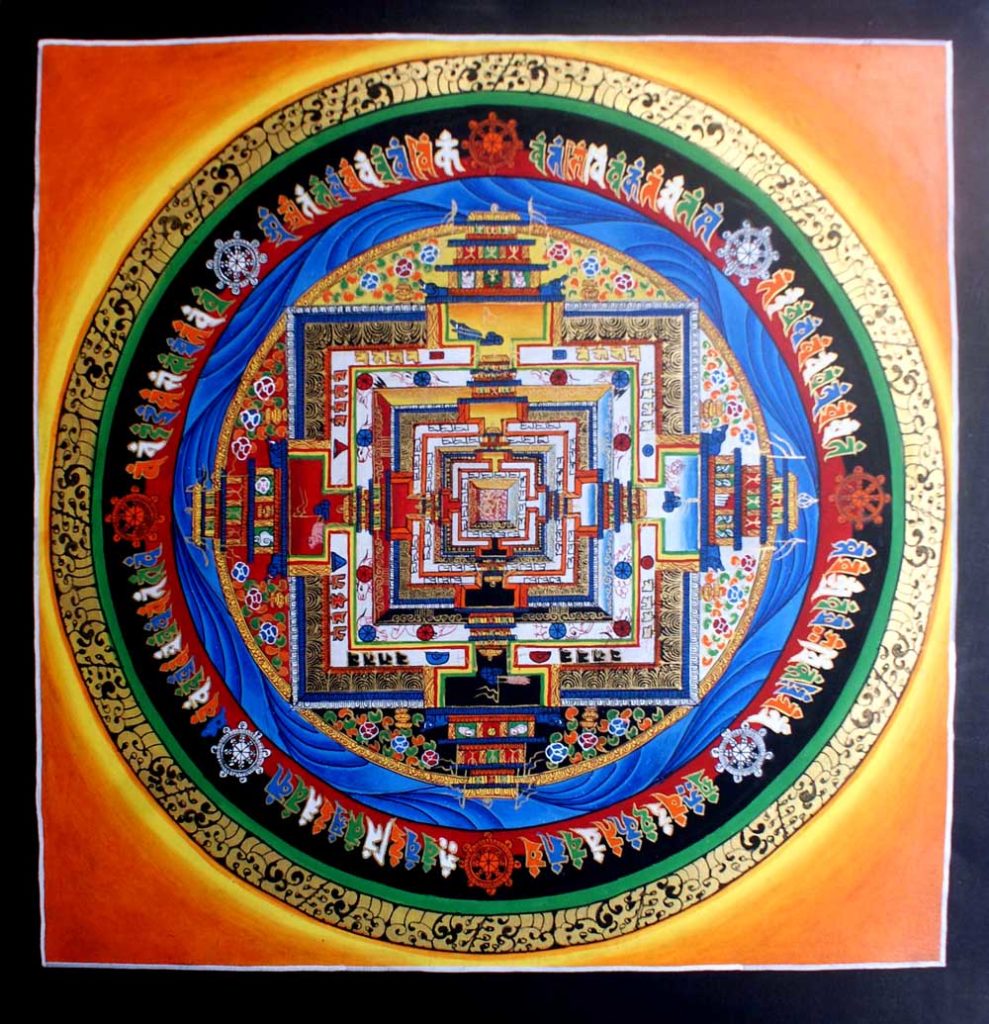
Tibet – Kalachakra mandala, designed by the Dalai Lama for the world peace.
To this day the traditional Tibetan clothes are worn. Women wear long dresses and long-sleeved shirts in many different colours of the rainbow. Women also wear colourful scarves and fleeces as a sign that they are married. Women wear colourful gowns and also set up their hair in braids. Outfits for men are based on the same style but obviously with less colours. Tibetans sometimes like to wear Western-style clothes too. Tibetans also wear warm tights and socks made of sheep and goat wool, which are also dyed in many colours and protect against freezing cold. Tibetans also wear hats made of sheep wool and long boots.
The presence of Tibetan people, their culture and their arts are not only visible in the territory of Tibet, but also in Nepal, states of Sikkim and Ladakh (India), and in certain Chinese provinces as Sichuan. Also Bhutan is based on Tibetan culture and Mongolia’s official religion is Tibetan Buddhism.
Media:
There are no official figures about the freedom of the press in Tibet, but it is easy to imagine how the freedom of speech and publication looks like, based on Chinese example. On the press freedom list China is now on 174th place out of 179 countries and territories, what means persecutions of journalists, including murder and imprisonment. However the situation in Tibet is even more dramatic. In China they can at least honestly write that panda is the pride of the nation, but nothing more than that. In Tibet the Chinese police patrols the streets, temples and private homes, and in Lhasa it is prohibited to talk about the Dalai Lama or to have his picture. All newspapers in Tibet are strictly controlled by China, what means that there is no freedom of press, publications or speech. Tibet is a land of slavery and the police state of China. Sometimes however people can no longer stand this terrible occupation. When I was there, a monk ran into the street and began shouting “Free Tibet, fuck China.” After that happened no one could ever see neither him nor his family. Even when I was at the post office in Lhasa to buy postcards, on the postcards was written: “Tibet, a beautiful region in the southwestern part of the People`s Republic of China.” Tourists from Europe often cross the last three words.
Environmental problems:
“Destruction of nature and natural resources results from ignorance, greed and the lack of respect for earth’s living things.”
-His Holiness the Dalai Lama, 1993
Tibet is one of the cleanest and the most beautiful ecosystems on Earth, and thanks to its inaccessibility its beauty was intact to a certain time. However today Tibet also has a number of problems related to pollution of nature, mainly because of the Chinese occupation. In the 50’s the vast Tibetan plateau was thriving with herds of animals, but in the 60s Chinese soldiers were shooting them with machine guns. Today, both Tibetan and Chinese people still hunt. Although hunting is prohibited, even politicians who banned hunting still do it. Logging in Tibet is beyond expectations of stupidity and greed, and planting trees is very inefficient. This carries a risk of massive flooding in other parts of Asia, and the striped, naked areas are subject to erosion and desertification. This situation can be simply translated into hunger, because the earth is not going to be suitable for cultivation or grazing animals. This burden is felt by a lot of species of animals including panda, whose natural habitat is subject to flooding. However in my opinion even without floods Chinese industries will poison pandas sooner or later. Another problem is the nuclear waste from nuclear stations built in Tibet, and already a lot of people got ill and died of an epidemic. Due to the ever growing huge Chinese population in Tibet, China does not want to import grain from China but to grow it in Tibet. This of course has fatal impact on the nature and customs of nomadic Tibetans. The Chinese also recover natural resources in Tibet, while leaving a huge footprint on the nature and they also leave Tibetan villages in chaos. By the way, whilst exploiting Tibet Chinese officials inspect monasteries and hold a tight grip on religious customs. China also wants to build a dam on lake Yamdrok-Tso in order to get hydroelectric energy and export it to Chinese cities. Taking into account the impact on nature and the legendary “Chinese quality” this project may result in the greatest environmental catastrophe of the XXI century.
The recent history of Tibet
The history of Tibet is very sad, partly similar to Polish history. In 1951, the Chinese people’s great leader Mao Tse Tung invaded Tibet and turned it into another province of China, as a strategically very important land located 4000-5000m above the sea level. Then in 1959 Tibetans made an uprising which failed. China stole Tibet`s independence and 100 000 Tibetans and its spiritual leader, had to leave Tibet forever. During the “cultural revolution” Chinese killed a total of approximately 1.2 million Tibetans and destroyed many cultural relics cherished for centuries. The most ironic in all this was that the Chinese have called the whole operation “the liberation of Tibet.” Another words (in their opinion) Tibet was liberated from their independence in favour of a strong China, which rescued them from feudalism. Tibetans hate all Chinese, and the Chinese people brought up on lies of communism honestly believe that they had helped Tibet, because they had built in Tibet an airport, roads, the developed tourism (in their own favour), they built schools and hospitals. What the Chinese did in Tibet they treat as a mission of grace. This situation continues until today and Dalai Lama is still the spiritual leader, who seeks not so much the complete independence, but the cultural and religious autonomy. In 1989, the Dalai Lama received the Nobel Peace Prize which aroused the sympathy of many Western countries to intervene in Tibet – but due to ruthless business without any change.

Tibetans at a well in Shigatse.
On the other hand I can understand the position of the Chinese government, because Tibet used to be a part of Ancient China. This is what the Chinese hold on to as their “innocence policy”. Besides, we are always sorry when we think about those who suffer, but Tibet was also killing and invading. Nepal for example was under Tibetan rule from the VII to the XII century. Every coin has always two sides, the same as temporary Western fashion for the freedom of Tibet.
Good luck Tibet !
Travel reports
Map
Location
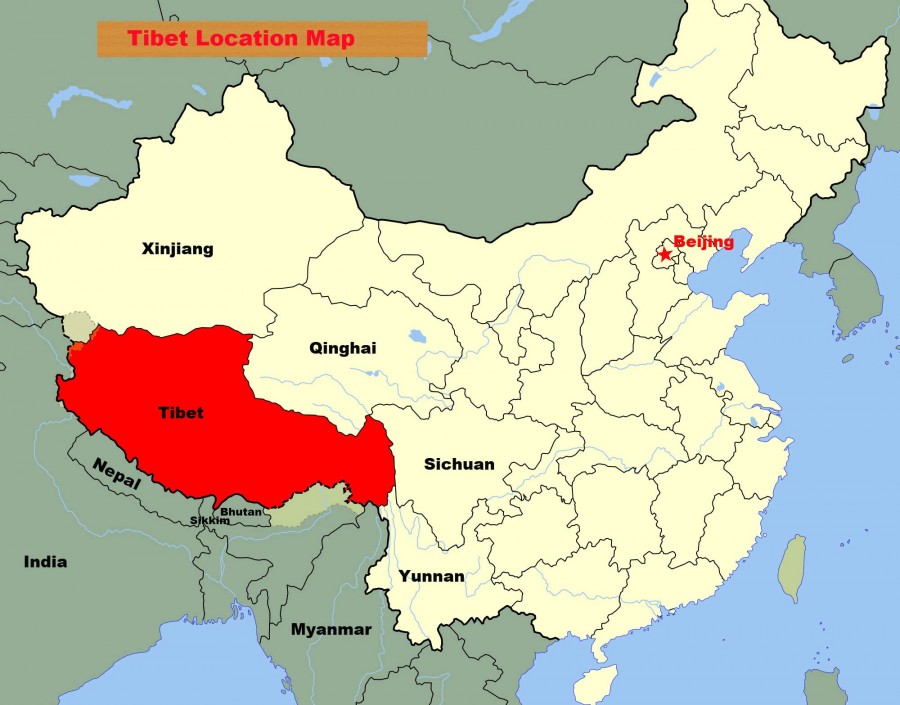
Practical information
Tourist Visa: As Tibet is a part of China, there are the same visa requirements as to China. The only exception is that Tibet requires a separate (paid) license dealt with in China. when applying for a Chinese visa I advise you to not say that you intend to go to Tibet. I advice to check up to date entry permits for Tibet as they change quite often. Depending from which side we`re going to enter Tibet, we can obtain this information in Nepal or China.
Safety: safe country. I advise you not to engage in conversation about politics.
Listen to the Tibetan mantra ‘Om Mani Padme Hum’. For people from the European civilization it is such nice and relaxing music, that they might also like it.
Moving around the country: The best form of transportation is to rent a car with a driver. There are buses between major cities, but you can not count on them.
Prices: (in 2006 when £1 – about 15CNY) hotels and food are very cheap. Even $10 – $15 per person per day is sufficient for modest conditions. Transport is most expensive when you hire a jeep at the tourist office, but it is essential to travel around Tibet.
Climate: Extremely dry, windy, continental. There are large variations in temperature between day and night, and winds and huge moisture evaporation results in strong sunlight. Temperatures in the same time of a year depend on the altitude, but generally it is about 20oC-25oC in summer and in winter, and around -20oC to -30oC during winter. High in the Himalayas it can be even about -50oC. Tibet, especially in the higher parts is characterized by low air pressure and low content of oxygen in the air. For this reason, acclimatization is needed because it can result in altitude sickness, which symptoms are recognized by dizziness and overall weakness.



